
About UsThe Numismatic Bibliomania Society is a non-profit organization promoting numismatic literature. For more information please see our web site at coinbooks.org SubscriptionsThose wishing to become new E-Sylum subscribers (or wishing to Unsubscribe) can go to the following web page link MembershipThere is a membership application available on the web site Membership Application To join, print the application and return it with your check to the address printed on the application. Membership is only $15 to addresses in the U.S., $20 for First Class mail, and $25 elsewhere. For those without web access, write to: David M. Sundman, Secretary/TreasurerNumismatic Bibliomania
Society AsylumFor Asylum mailing address changes and other membership questions, contact David at this email address: dsundman@LittletonCoin.com SubmissionsTo submit items for publication in The E-Sylum, just Reply to this message, or write to the Editor at this address: whomren@coinlibrary.com
BUY THE BOOK BEFORE THE COINYou won't regret it! |
- WAYNE'S WORDS: THE E-SYLUM JULY 26, 2009
- LAKE BOOKS SALE #99 CLOSES JULY 28, 2009
- FANNING NUMISMATIC LITERATURE ISSUES THE JULY 2009 BOOKSHELF
- NEW BOOK: MEDALS OF DISHONOUR
- ON THE ADAMS U.S. AUCTION CATALOGS BOOK REPRINT
- JOE BOLING ON KRAUSE COINS OF THE WORLD DIGITAL PRICE GUIDE
- MEDALLIC ART COMPANY HAS A NEW OWNER
- ANCIENT COIN AUCTION INDEX WEB SITES
- ON BOUND SETS OF STACK'S JOHN J. FORD COLLECTION, 2003-2007
- MORE ON COMPLETE SETS OF COIN WORLD
- MORE ON HENRY AND WILLIAM CHRISTENSEN
- MORE ON THE CALCUTTA MINT
- 1792 LIBERTÉ FRANÇOISE MEDAL
- A HANDY FLASHLIGHT FOR COIN VIEWING
- QUERY: PARIS MINT ARCHIVE RESEARCH
- NUMISMATIC SOUVENIRS OF THE 1906 SAN FRANCISCO EARTHQUAKE
- COIN TRICKS FOR THE POLITE HOST OR HOSTESS
- QUERY: NUMISMA AND ESSAY-PROOF JOURNAL ARTICLES SOUGHT
- QUERY: ARE NOBEL PRIZE MEDALS CAST OR STRUCK?
- QUERY: AUTHOR JAEGER SEEKS TOKEN AND MEDAL INFORMATION AND IMAGES
- METAL DETECTORIST UNEARTHS U.K.'S OLDEST ROMAN COIN
- CANADA'S BIG NICKEL CELEBRATES AN ANNIVERSARY
- THE AMERICAN WATERCOLOR SOCIETY AWARD MEDAL
- WALL STREET JOURNAL ON CALIFORNIA'S IOU'S AND THEIR PREDECESSORS
- CAPTAIN BARTLETT’S BARROOM BILLS
- CHALLENGE COIN STOPS BULLET FIRED AT FLORIDA OFFICER
- $190,000 IN TWENTIES, PLEASE
- WOMAN THRASHES HUSBAND WHO TOOK HOME FAKE NOTE
- FEATURED WEB SITE: THE UK DETECTOR FINDS DATABASE
WAYNE'S WORDS: THE E-SYLUM JULY 26, 2009
 Among our recent subscribers is Don Fraser. Welcome aboard! We now have 1,241 subscribers.
Among our recent subscribers is Don Fraser. Welcome aboard! We now have 1,241 subscribers. Regarding our periodic format issues with the HTML version of the newsletter, Pete Smith writes: "Whoops, you did it again!" He's right - several folks, myself included, got their issue with much of the text pushed off to one side. Sorry! This has been a tough problem to track down. Like most software developers, I can only say, "Well, it works on MY machine..."
Anyway, thankfully the NBS E-Sylum archive is updated lickety split by our able webmaster Bruce Perdue, and those pages seem unaffected by the problem. So readers can always get their E-Sylum news there. Here's the link to last week's issue: www.coinbooks.org/club_nbs_esylum_v12n29.html
And if you're having trouble reading the current issue, try here: www.coinbooks.org/club_nbs_esylum_v12n30.html
And here's another oops: it was Ron Abler, not Ron Benice who submitted the American Medal scale size conversion chart. Sorry! - all my fault. Thanks again to everyone for their responses.
To learn about coin tricks for the polite host or hostess, Captain Bartlett’s barroom bills, girlfriends and wives on a rampage in Florida and China, and the dog with six tails in Thatcham, read on. Have a great week, everyone!
Wayne Homren
Numismatic Bibliomania Society
LAKE BOOKS SALE #99 CLOSES JULY 28, 2009
FANNING NUMISMATIC LITERATURE ISSUES THE JULY 2009 BOOKSHELF
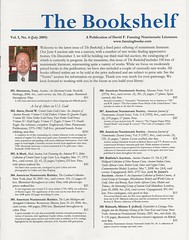
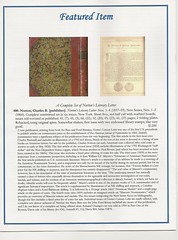
NEW BOOK: MEDALS OF DISHONOUR
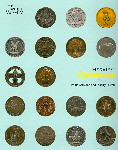 Alongside the longstanding and well-known association of medals with glory and achievement lies another darker tradition of the medal as an indicator of dishonour. Medals of Dishonour will reveal this little-known history, and will also show internationally renowned contemporary artists engaging with the medal as a vehicle for political and social comment.
Alongside the longstanding and well-known association of medals with glory and achievement lies another darker tradition of the medal as an indicator of dishonour. Medals of Dishonour will reveal this little-known history, and will also show internationally renowned contemporary artists engaging with the medal as a vehicle for political and social comment. The first part of the catalogue consists of a representative selection of about twenty medals of the 17th-20th centuries, including Dutch medals satirizing James II and Louis XIV, German and British medals on financial scandal and political corruption, a French medal showing Napoleon III as a cockchafer, German WWI anti-war medals, and two of David Smith's Medal for Dishonor.
The second part consists of medals and related drawings recently commissioned by the British Art Medal Trust from twelve celebrated contemporary artists. The artists were asked to make works focusing on important issues of our times. Subjects include war, race, ASBOs (Anti-Social Behaviour Orders: a recent British phenomenon) and our modern obsession with shopping. 136p, 170 colour illus. (British Museum Press 2009)
To order the book from David Brown, see: www.oxbowbooks.com/bookinfo.cfm/ID/69552/Location/DBBC
To read the earlier E-Sylum article, see: AUDIO SLIDESHOW: MEDALS OF DISHONOUR (www.coinbooks.org/esylum_v12n26a07.html)
Ian adds:
ON THE ADAMS U.S. AUCTION CATALOGS BOOK REPRINT
Regarding John Adams' United States Numismatic Literature Volume I, Nineteenth Century Auction Catalogs, last week Robert Rightmire asked: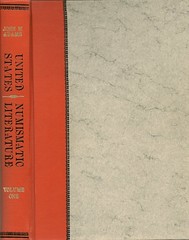
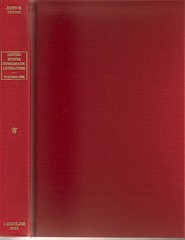
Publisher George Kolbe explains:
The original was printed in two colors throughout on the best acid-free paper available at the time (i.e., expensive at a time when most books were printed on acid stock), and it was bound by hand by Kater-Crafts in Pico Rivera, California.
Typesetting and two-color trapping costs were substantial (remember, computer typesetting and formatting were in their infancy if available at all). Other factors were the substantial cost involved in commissioning twenty-one original drawings for the book and the oversize format.
To read the earlier E-Sylum article, see: QUERY: ADAMS U.S. AUCTION CATALOGS REPRINT (www.coinbooks.org/esylum_v12n29a07.html)
JOE BOLING ON KRAUSE COINS OF THE WORLD DIGITAL PRICE GUIDE
Regarding Krause Publications' Coins of the World digital price guide series, Joe Boling writes:To read the earlier E-Sylum article, see: NEW E-BOOKS IN KRAUSE PUBLICATIONS' COINS OF THE WORLD SERIES (www.coinbooks.org/esylum_v12n28a04.html)
THE BOOK BAZARRE
MEDALLIC ART COMPANY HAS A NEW OWNER
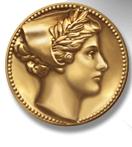 For the sixth time in its 103-year history Medallic Art Company has a new owner. Ross Hansen, who had built the largest private mint in America over the last 25 years in Auburn, Washington -- Northwest Territorial Mint -- has purchased the Medallic Art firm of Dayton, Nevada, from Robert Hoff on July 10. The purchase agreement was announced this week.
For the sixth time in its 103-year history Medallic Art Company has a new owner. Ross Hansen, who had built the largest private mint in America over the last 25 years in Auburn, Washington -- Northwest Territorial Mint -- has purchased the Medallic Art firm of Dayton, Nevada, from Robert Hoff on July 10. The purchase agreement was announced this week.The new owner plans to move all his operations to Dayton, Nevada. The building there, a one-time plastic manufacturer before Bob Hoff occupied it in 1999, is ample size. Hansen plans to move 200 of his employees from Auburn to Nevada, and retain 16 of Medallic Art’s existing employees. He also will move 300 pieces of equipment to consolidate all of his operations in the Dayton plant.
Here is a list of the owners of Medallic Art Company over last century:
1906-1909 -- From the first medal struck in 1906 the first owners were the Deitsch Brothers. They employed Henri Weil who obtained the first Janvier die-engraving pantograph in France and imported it to America.
1909-1929 – Henri Weil and brother Felix Weil purchase the Janvier machine and the name Medallic Art Company from Deitsch Brothers and operate the firm for two decades.
1929-1960 – The Weils sell controlling interest in Medallic Art Company to Clyde Curlee Trees, who they had hired in 1919 to operate the business, but they agree that one brother will be on hand at all time. That suits them well as it gives each brother a six-month vacation every year, often returning to their native France.
1960-1972 -- On Trees death ownership passes to three owners: Trees' nephew, William Trees Louth, his widow, Frances Kimberle Trees who had been active in the firm, and his oldest employee, Julius Lauth. Bill Louth assumes the presidency and oversees a four-man sales staff, Mrs. Trees becomes the firm’s treasurer in charge of the office staff, and Lauth (no relation to William, spelled differently) becomes vice president, art director and in charge of all production. Under the triumvirate the firm flourishes.
1972-1989 – The three owners sell to a group of investors headed by Donald Schwartz, who built a new plant in Danbury, Connecticut, but business declines after the 1976 American bicentennial and the new owners are unable to keep the firm viable.
1989-2009 – The firm is acquired by Robert Hoff, of Tri-State Mint, in Sioux Falls, South Dakota, who in 1997, moves the firm to Dayton, Nevada.
2009 – Medallic Art Company is acquired by Ross Hansen, of Northwest Territorial Mint, of Auburn, Washington, who relocates all production facilities to Dayton, Nevada.
To visit the Medallic Art Company web site, see: www.medallic.com
ANCIENT COIN AUCTION INDEX WEB SITES
Jim Duncan writes:
Jonathan Brecher writes:
If enough auction houses insisted that he provide the information for free or not at all, that might put a little bit of pressure where it would do some good...
I've used the site in the past, but it isn't worth $6 to me for a year's worth of access, much less $600/year. I wouldn't mind seeing access restored. I can certainly live without it, though.
On the other side of the fence, one of our coin dealer friends writes:
The announcement says that the site had planned to launch later in the year, but "hurried a bit" to launch this week.
I wish them the best of luck! The site is visually pleasing. Unlike CoinArchives, if there are more than 1000 results it is possible to view them all. Unfortunately, acsearch.info only shows 20 coins per page meaning a lot of clicking and scrolling when dealing with large query responses.
Lars and Simon's previous site was romanatic.com. It will be interesting to see if they have any kind of cross-linking planned for the two sites. Currently Romanatic lets users search WildWinds and CoinArchives, and I'd expect an acsearch.info link can't be far away. It will be more interesting to see if they can come up with a way to automatically generate links from acsearch.info results to scholarly information on Romanatic.
To read the original blog post, see: acsearch.info (digitalhn.blogspot.com/2009/07/acsearchinfo.html)
ON BOUND SETS OF STACK'S JOHN J. FORD COLLECTION, 2003-2007
This week Robert Rightmire posted the following questions regarding sets of Stack's Ford sales on the Collectors Universe forum:- Soft-bound sets are going for $500-750; supply apparently is rather limited.
- Hard-bound sets are very scarce; owners are not parting with them and few thought to buy extra sets. Initially they were purchased at $90-100; now the price would be/is much higher. Are there any sellers?
- It seems that a few parts are more scarce than others. Not much agreement on which parts are scarce. A survey might answer this question. Would Stack's reveal their publication numbers?
- There were red leather sets and 4-5 sets bound in grey leather. I haven't been able to confirm this assertion.
- The auction record to date for a hard-bound: Part I, Kolbe, June 2009, lot 596: $425.00!
- Apparently Stack's is reporting that the total proceeds for the Ford auctions was over $60 million. Since Ford items were sold elsewhere too, the total for his collection has to be even greater.
There is a tale to be told here; it may take some time for the rumors to settle and the facts to solidify. The set's high ranking (no. 6) on the NBS One Hundred Greatest Items list ensures that interest will only increase.
MORE ON COMPLETE SETS OF COIN WORLD
In 1994 I got a call from Remy Bourne who was closing the advertising agency he ran in a Minneapolis suburb. He had acquired a complete set of Coin World that he stored at his business. He also had an incomplete set of Numismatic News. I could have these if I hauled them away. It took a couple of trips to move these to my kitchen. I recall this was in about 30 large boxes that took up more space than I could afford to devote to storage.
I intended to go through the issues looking for biographical material for my book, American Numismatic Biographies. My initial review took hundreds of hours over about two years. If I found something I wanted to keep, I tore out that page. Then the rest went into the recycling bin.
I believe that Remy would have sold the set if he could have gotten enough to justify the shipping cost. When he was in the literature business I believe he was offered long runs of Coin World that he declined. I didn’t have the space to store it and didn’t know what else to do but destroy it.
A complete set of Coin World contains an incredible wealth of information. However, I believe there are reasons why few collectors have an interest in keeping it.
- 1. A complete set requires a large amount of storage space.
- 2. The paper deteriorates. Pages were crumbling as I went through them.
- 3. With no index, it may be impossible to find the treasures that are contained. Who would be willing to page through that volume of material looking for something?
- 4. Most researchers look for something once. Few have the need to go back for repeated use.
- 5. This is a research tool, not a collector’s item. There are more collectors than researchers.
- 6. Most numismatic libraries are overfilled with other material already.
My biography clipping file is in an alphabetical sorter about 15 inches deep. My other clippings would make a pile about three feet high. That takes up enough space in my library. Now, fifteen years later, the clippings are mostly disorganized. I do use the biography file frequently.
To read earlier E-Sylum article, see: TRACKING SETS OF COIN WORLD (www.coinbooks.org/esylum_v12n29a09.html)
MORE ON HENRY AND WILLIAM CHRISTENSEN
Q. David Bowers writes:Ted Buttrey submitted these thoughts on Henry Christensen:
Perhaps I might add that neither Henry nor any other dealer who thought the bars to be false was willing to go public, since everyone was afraid of Ford's repeated threats of legal action. When I went on to write up the exposure of those fakes I could not get it published in the U.S., so it came out in a Mexican journal and was circulated in the U.S. in that way.
David Lange, author of Collecting Boards of the 1930s and 1940s writes:
To read the earlier E-Sylum article, see: WILLIAM B. CHRISTENSEN (www.coinbooks.org/esylum_v12n29a18.html)
MORE ON THE CALCUTTA MINT
Jim Duncan of New Zealand writes:Richard Doty writes:
Doty adds:
To read the earlier E-Sylum article, see: FEATURED WEB PAGE: CALCUTTA MINT (www.coinbooks.org/esylum_v12n29a28.html)
1792 LIBERTÉ FRANÇOISE MEDAL
In my numismatic diary last week I wrote:Bill Eckberg adds:
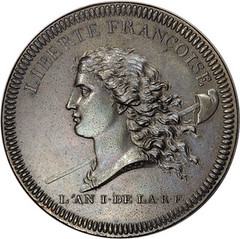
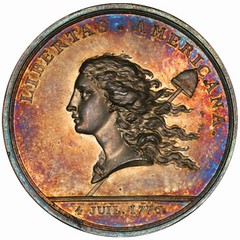
From the Heritage web site:
To view the full description on the Heritage web site, see: 1792 French Liberté Françoise Medal. (coins.ha.com/common/view_item.php?Sale_No=462&Lot_No=81612)
A HANDY FLASHLIGHT FOR COIN VIEWING
In my recent numismatic diary I wrote:In response Joe Boling writes:
In addition to general utility (like, when there is a power failure), I use it for all manner of numismatic purposes, especially judging exhibits - I never have to worry about how dim the hall's lights are, or if they have been turned to half-power for the evening hours. It's the best $50 investment I ever made. It is totally unmarked, but came with packaging identifying it as an Inova X5MT-WB LED floodlight. Made in China, no doubt.
QUERY: PARIS MINT ARCHIVE RESEARCH
Harold Levi writes:I have contacted the Paris Mint, but they simply responded with the snail-mail address of their archives. Does anyone have experience with this and/or any suggestions before I proceed?
NUMISMATIC SOUVENIRS OF THE 1906 SAN FRANCISCO EARTHQUAKE
Regarding earthquake items, Dave Schenkman writes: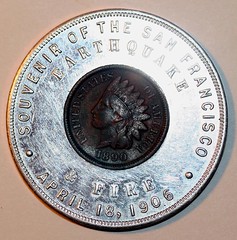
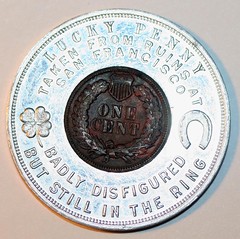
Obverse text: SOUVENIR OF THE SAN FRANCISCO / EARTHQUAKE & FIRE / APRIL 19, 1906
Reverse text: LUCKY PENNY / TAKEN FROM RUINS AT / SAN FRANCISCO / BADLY DISFIGURED / BUT STILL IN THE RING
I really like this encased cent. It's a great way to dress up and give new life to a beat-up lowly cent - a harmless and interesting souvenir of a catastrophic historic event. I love the prize fighter allusion: "badly disfigured but still in the ring" and the double meaning of "ring", which could mean a boxing ring or, of course, the aluminum ring that comprises the encasement.
Dave adds:
Joe Boling adds:
THE BOOK BAZARRE
COIN TRICKS FOR THE POLITE HOST OR HOSTESS
The preface sums it up: "This collection of games and stunts has been prepared for the express purpose of meeting the many requests of the day for successful recreation programs for large and small groups of men and girls, in which round-dancing has no part." (Reminds me of the old joke: "Why do Baptists disapprove of premarital relations? Because it might lead to dancing.")
The book is divided into chapters on ice-breakers, stunts, parties, races, games, etc. The section "Tricks" includes one called "The Elusive Dime" --- sure to pique the interest of any collector. It reads:
What hijinks! At the ANA World's Fair of Money next month, when you're relaxing with some friends, pull out a dime --- make sure it's a Barber dime with a good clear milling around the edge --- and break the ice with a good old-fashioned numismatic prank. I imagine a raw dime will work best, as opposed to a slabbed one.
There are a few other games and stunts involving coins in the book. Interested E-Sylum readers are directed to Ice Breakers and the Ice-Breaker Herself (Edna Geister, The Woman's Press, New York City, 1921).
P.S. I bought this book at the same flea market where, a few weeks ago, I found Stephen King's Skeleton Crew, which includes a short story with a walk-on cameo by a mysterious bag of double eagles.
QUERY: NUMISMA AND ESSAY-PROOF JOURNAL ARTICLES SOUGHT
1) Dr. Glenn Jackson's article, entitled U.S. Currency Printed on Confederate Watermarked Paper, which appeared in the Essay-Proof Journal, No. 107. Sorry, but I don't know the date.
2) From New Netherlands Coin Company, May, 1955 issue of Numisma, article on Fractional Currency Listing
If any of our fellow readers have these in their library and can contact me I'd be grateful. My e-mail address is jfochtman@bradmark.com Thanks!
QUERY: ARE NOBEL PRIZE MEDALS CAST OR STRUCK?
Kerry Rodgers of New Zealand writes:
To do the trick one part of concentrated fuming nitric acid needs to be added for every three parts of concentrated fuming hydrochloric. This of course produces what is commonly known as aqua regia or king water.
It will cheerfully dissolve gold and platinum but loses its efficacy if allowed to stand. If you are planning a heist along these lines, it needs to be mixed fresh for best results. From experience, I recall that you also need a bit of patience.
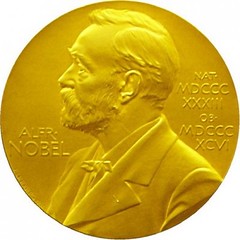
The Franck and von Laue medals are a great story. Of course, it wasn't the medals that were hidden so much as their gold. This was precipitated after WWII and returned to the Nobel Institute who used it to restrike/recast their medals.
Now there's a question: are Nobel medals cast or struck?
QUERY: AUTHOR JAEGER SEEKS TOKEN AND MEDAL INFORMATION AND IMAGES
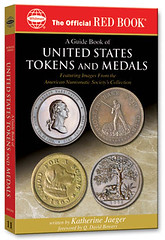 Whitman Publishing author Katherine Jaeger is preparing for upcoming editions of A Guide Book of United States Tokens and Medals. She seeks full-color photographs and information to expand the book’s coverage of the following exonumia categories:
Whitman Publishing author Katherine Jaeger is preparing for upcoming editions of A Guide Book of United States Tokens and Medals. She seeks full-color photographs and information to expand the book’s coverage of the following exonumia categories:- Merchant tokens from the states of South Carolina, West Virginia, Wisconsin, and Wyoming.
- Civil War tokens (storecards) from the states of Alabama, Kansas, Kentucky, Maine, New Hampshire, and Virginia
- Sutler tokens: any
- Lumber company tokens
- 20th-century military commissary tokens
- Prison commissary tokens
- Gambling-machine tokens
- Music-machine tokens
- Transportation tokens
- State sales-tax tokens
- Emergency relief-tax tokens
- Food-stamp change tokens
- Movie tokens
- Medals of the space program
- Exposition souvenirs
- Arras (wedding) tokens
- Commemoratives of 1858–1861 (diesinkers’ and coin dealers’ medals
- Augustus B. Sage tokens, odd mulings)
- Franklin Mint coin medals
- Presidential campaign medals and tokens (supportive pieces, satirical pieces, ferrotypes)
- Political-cause medals and tokens (abolitionist)
- Inaugural medals, 1790s–1830s
- Indian Peace medals, 1800s
- Abraham Lincoln medals/tokens, 1800s to early 1900s
- Academic medals, 1770s to early 1850
- Firefighters’ medals, 19th century
- Membership medals, 1890s to current
- Love tokens and engraved coins
- Enameled coins
Collectors with information may contact Whitman publisher Dennis Tucker at dennis.tucker@whitmanbooks.com or 404-235-5348.
Jaeger will also be at the American Numismatic Association World’s Fair of Money, August 5–8, autographing copies of the Guide Book of United States Tokens and Medals and the award-winning 100 Greatest American Medals and Tokens (which she coauthored with Q. David Bowers).
METAL DETECTORIST UNEARTHS U.K.'S OLDEST ROMAN COIN
"It came out of the ground all brown, and I used a bit of spit and a bit of sheep's wool to clean it and it came up silver."
Malcolm said he discovered the age of the coin when he took it, along with another Iron Age silver coin of Eppillus to the West Berkshire and Oxfordshire Finds Liaison Officer, Anni Byard, so she could record them.
Anni immediately confirmed the Iron Age coin was only one of 11 that have been recorded in the UK and suspected the Roman coin, a Republican silver denarius, was quite rare.

She said: "I almost fell of my chair when I found out what date it was, it's in almost mint condition, which shows it was here much earlier than other Roman coins.
"Historically it's a wonderful find and I think Malcolm should be very proud.
The silver denarius depicts the helmeted head of Roma on the obverse and the galloping Dioscuri on the reverse.
The coin was struck in Rome during the Republican period, just two years before the Roman general Scipio defeated Hannibal near Carthage.
Republican silver denarii are often found in Britain, and although the coins began to be struck in Rome in 211 BC, this new coin appears to be the earliest denarius recorded from Britain, earlier than any of the 600 similar coins which have been recorded.
Malcolm said: "I was so excited I was like a dog with six tails, I didn’t know which one to wag first!"
To read the complete article, see: UK's oldest Roman Coin found in Thatcham (www.bbc.co.uk/berkshire/content/articles/
2009/07/24/roman_coin_feature.shtml)
CANADA'S BIG NICKEL CELEBRATES AN ANNIVERSARY
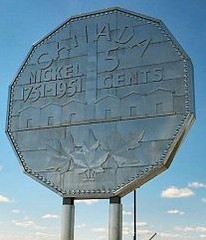 There is a numismatic park in Sudbury, Ontario, Canada. It is home to the Big Nickel, a 30-foot tall statue of a giant 1951 Canadian nickel that celebrated its 45th birthday this week. On hand for the anniversary party was Ted Szilva, sculptor of the statue.
There is a numismatic park in Sudbury, Ontario, Canada. It is home to the Big Nickel, a 30-foot tall statue of a giant 1951 Canadian nickel that celebrated its 45th birthday this week. On hand for the anniversary party was Ted Szilva, sculptor of the statue. "My dream came to fruition," he said. "I don't know if I have thanked the people of Sudbury. I know the city gave me a rough time with the permits (back in the 1960s). They thought it was a Mickey Mouse operation...I'm very proud and very thankful to God that he inspired me to create it."
Szilva went on to create a Big Lincoln Cent, a Big Canadian Cent -- but called the "Big Pennies" in these parts -- and a Big Kennedy Half Dollar. That completed the numismatic park.
But he also created a Big Nickel Mine, a statue in tribute to the source of the metal that is such a great contribution to the economy of the area. There is even an exhibit of nickel coins of the world provided by Inco, the firm that provides that metal to mints of the world.
Nickel is a super hard metal in pure state, but when alloyed with other metals it provides the right combination for coinability and other characteristics like wearability, as evidenced by copper-nickel, one of the most universal coin metal alloys.
But there is another numismatic angle to The Big Nickel story. To raise money back in 1963-64, when Szilva was building the statue, he created and sold medals to underwrite the cost. If memory serves me right, it was that same 1951 nickel in a size, of course, larger than the coin. And I'll wager an E-Sylum reader will respond, "Hey, I have one of those!" Prove it. Send Wayne an image.
So here's a toast to The Big Nickel, Happy Birthday! And thank you Ted Szilva. Salute!
To read the complete article, see: Big Nickel remains tourist draw (www.thesudburystar.com/ArticleDisplay.aspx?e=1668225)
THE AMERICAN WATERCOLOR SOCIETY AWARD MEDAL
Writing to Dick, Rich Jewell asked:
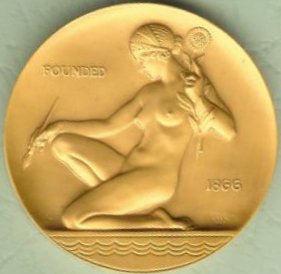 I have an American Watercolor Society Award Medal, gold plated bronze 2-1/2", Maco. I can not read who the engraver is, and there appears to be a date of 1933 just above the exergue line in the lower right corner. The medal itself is very Art Deco-ish. The obverse has a lovely nude female kneeling facing left, holding a paintbrush in her right hand and holding a sunflower in her left hand.
I have an American Watercolor Society Award Medal, gold plated bronze 2-1/2", Maco. I can not read who the engraver is, and there appears to be a date of 1933 just above the exergue line in the lower right corner. The medal itself is very Art Deco-ish. The obverse has a lovely nude female kneeling facing left, holding a paintbrush in her right hand and holding a sunflower in her left hand. The reverse has a geometric maze design with two sea shells on other side of the design. The legend surrounding the rim reads: "AMERICAN WATERCOLOR SOCIETY AWARD." It is unawarded. If you can assistant me in identifying the engraver I'd be very appreciative and any other information on the society, etc..
Dick Johnson replied:
It was struck by Medallic Art Company, it is their catalog number 33-6. It was struck and issued over the years in gold, silver and bronze. You can Google the American Watercolor Society, I have no other data on the society.
No. This is not a Restrike, not a Replica, not a Reissue. This medal is in an active medal award program. The original striking may be spread out over years or even decades. I will explain.
When I worked at Medallic Art Company in the sixties and seventies we had a caged area, hands off to everyone. We called this "Customers' Property." Medallic Art would work an agreement with the association, institution, university or firm that managed the award program.
Once the dies are made the big expense in striking medals is the setup of the press. (I don't remember the cost at the time, but say it was $500.) An arrangement was made to strike enough medals in advance, say for ten years, the customer would pay for all in full and Medallic Art would retain these medals in Customer Property.
When needed to be awarded we would retrieve one or as many as necessary and do any inscribing, plating, finishing or special mounting required. The bill for that year would be for only the services performed. This, obviously, would not include the $500 press setup cost. The was a substantial cost saving for the client each year, and relieved the firm of constantly setting up the press, say, to strike one or two medals. It worked to the benefit of all.
Thus, in my databank I have made special note for every award medal to indicate the years in which the medal award program was active. This is indicated as: "(date/issued 19xx-19xx)" with the exact years first issued and last issued. I have record of most "first year of issue." Now I often have to rely on auction sales or collectors' records of the "last year of issued." This date is often inscribed on the medal as the date of presentation.
To view The E-Sylum photo archive, see: www.flickr.com/photos/coinbooks/
To see an unedited scan of the American Watercolor Society Award Medal reverse, see: www.flickr.com/photos/coinbooks/3754139946/
WALL STREET JOURNAL ON CALIFORNIA'S IOU'S AND THEIR PREDECESSORS
During the Great Depression, hundreds of communities as strapped for cash as California is today circulated their own temporary currencies. An estimated $1 billion in this scrip was issued by towns and counties, not to mention corporations, school boards, newspapers and a few wealthy individuals. Most promissory notes looked like paper currency, but scrip was also printed on leather, metal, fish-skin parchment and, in Tenino, Wash., on slabs of two-ply Sitka Spruce.
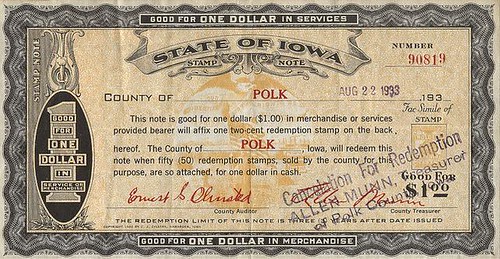
Today, collectors treasure remnants of those desperate times: a green-and-gold "sauerkraut note" from Minneapolis; a warrant, beautifully printed with an engraving of a clipper ship, from Cape May County, N.J. Some imagine filling out their collection with Schwarzenegger scrip, circa 2009.
"Every piece tells a story," says Neil Shafer, author of the "Standard Catalog of Depression Scrip of the United States," published in 1984. "It represents a piece of social history."
Since California ran out of cash early this month, it has issued more than 194,000 IOUs, with a total value of $1.03 billion. They are redeemable in U.S. dollars on Oct. 2, or sooner if the state comes up with the money. The legislature on Friday approved a plan to close a $24 billion budget gap, but officials say it could still take a few weeks to analyze the state's cash situation and resume giving creditors checks instead of promises.
California IOUs differ from Depression-era scrip in a key respect: They are made out to individual creditors for specific amounts. Scrip in the 1930s was designed to circulate like currency and usually issued in standard denominations: 25 cents, $1, $5.
Issuance exploded in early 1933, as banks in city after city suspended operations in the face of runs on their teller windows, severely restricting the amount of money in circulation. On March 6, President Franklin D. Roosevelt shut down nearly all transactions in a "bank holiday," even as he prodded the Federal Reserve to hurry up and print more currency. Some banks reopened within days, but others remained shut for weeks. People and businesses ran out of cash.
Some turned to barter. The New York Daily News, which was sponsoring a boxing match at Madison Square Garden, offered a ticket in exchange for any item worth 50 cents. Fans brought in spark plugs and nightgowns, frankfurters and jigsaw puzzles, New Testaments and noodles and golf knickers, says Mr. Shafer, who chronicled the era in his book.
But barter goes only so far. Makeshift currencies soon were popping up everywhere.
Each note of the funny money was supposed to be backed by the assets of the issuer. For the most part, the system worked: When the crisis passed, holders of scrip were able to redeem it for legal tender.
Though a few issuers saved stashes of their scrip, and it now can be bought cheaply at online auction sites, many other issuers destroyed the notes after they were redeemed. With those bills, the few that survive can fetch hundreds of dollars. Rod Charlton II, who runs a Web site called DepressionScrip.com, says there is no bigger thrill than finding an unusual note online. "I can't sleep at night because I want to get hold of it so bad," he says. "It's that kind of obsession."
California's IOUs lack the flair of much Depression-era scrip; they are basic, pale-green government-issue checks, except they bear the telltale label "Registered Warrant." Still, collectors say they would make good souvenirs of today's financial crisis. The trick will be getting hold of one. California plans to destroy the IOUs after they are redeemed. And state officials say they expect a high redemption rate.
"The people who got them probably aren't sitting around thinking, 'I'm going to save this for posterity,' " says Mr. Gatch, the political scientist. "They're more likely thinking, 'How the hell am I going to cash this?' "
To read the complete article, see: Cash-Strapped California's IOUs: Just the Latest Sub for Dollars (online.wsj.com/article/SB124846739587579877.html)
CAPTAIN BARTLETT’S BARROOM BILLS
Customers, displaying varied degrees of mental acuity, used black markers to scroll their names, dates and other messages in a paper trail for posterity.
With demolition of the Bartlett at hand, the cleanup crew gave the Fairbanks Community Food Bank the opportunity to salvage the monetary remains of the bar.
They recovered more than $2,100 in a two-day operation requiring the careful removal of thousands of staples, lest torn images of George Washington end up as the face upon the floor. One bill was reported to contain 24 staples.
The plan was to deposit the old bills at Denali State Bank, from where they would be shipped to the Federal Reserve, destroyed and replaced with fresh currency.
In glancing through the messages and notes on the bills, most ranged from profane to pathetic, with occasional stabs at barroom philosophy. “Never look back. Always look forward,” someone wrote in red.
Some of the authors complained about their bosses, the police, old girlfriends and the weather, while others offered opinions that must have made sense at the time or proudly proclaimed San Antonio or Chicago as home. There were quite a few farewells to Alaska that no one ever read in the light of day. These were not messages in a bottle, but messages about the bottle.
"Last beer in Alaska. I’ll miss you guys," was one.
Other notes were more celebratory. "Girls Night Out!" "Wonder Woman was Here!"
In addition to the legal tender from the U.S., there were bills in many denominations from Belgium, Sweden, Qatar, Egypt, Pakistan, Venezuela, Singapore, China, Indonesia, Malaysia, New Zealand and a dozen other nations.
There were about 1,650 dollar bills in the collection, along with one $10, one $20, six $5 and six $2. I suspect that perhaps there were more $20 bills placed on the ceiling or wall, but thirsty patrons removed them from the premises when the bar was open and spent them.
The hotel is to be demolished shortly, which will bring an end to an institution that was the Captain Bartlett Inn since 1977 and the King 8 Hotel before that.
To read the complete article, see: Thousands of Captain Bartlett’s barroom bills salvaged to benefit food bank (www.newsminer.com/news/2009/jul/24/thousands
-captain-bartletts-barroom-bills-salvaged/)
CHALLENGE COIN STOPS BULLET FIRED AT FLORIDA OFFICER
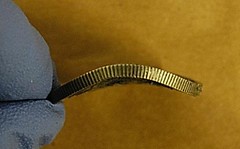 The girlfriend of a man arrested in the shooting of a Florida Fish and Wildlife Conservation Commission officer in Brevard County was ordered held without bond on Friday, while authorities released images of a coin that stopped one of six bullets fired at the man.
The girlfriend of a man arrested in the shooting of a Florida Fish and Wildlife Conservation Commission officer in Brevard County was ordered held without bond on Friday, while authorities released images of a coin that stopped one of six bullets fired at the man.Streety, 42, was shot at about 8 p.m. Wednesday after checking on a suspicious car on Satellite Boulevard, just south of state Road 528 in Canaveral Groves, west of Cocoa. Streety, who was wearing a bulletproof vest, suffered gunshot wounds to his wrist, shoulder and hip. A bullet went through his rear pocket and lodged in his wallet, alongside a coin that stopped the bullet.
The bent gold coin says "FWC SOG Police" on one side and has the words honor, integrity and justice on the other side. SOG stands for Special Operations Group.
Streety is recovering at Holmes Regional Medical Center in Melbourne.
To read the complete article, see: Coin Stops Bullet Fired At Officer (www.clickorlando.com/news/20090775/detail.html)
$190,000 IN TWENTIES, PLEASE
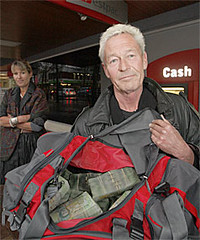 Roger Griffiths, a successful artist is Mapua, New Zealand, lost it when Westpac, the bank he'd been with for 25 years, declined to give him a NZ$80,000 mortgage because, as an artist, he doesn't have a regular income. He does, however, have a ton of property, a gallery show in NYC, and NZ$190,000 on deposit with Westpac. Which he promptly withdrew. In twenties. And then he deposited it with his local, community-oriented credit union, the Nelson Building Society.
Roger Griffiths, a successful artist is Mapua, New Zealand, lost it when Westpac, the bank he'd been with for 25 years, declined to give him a NZ$80,000 mortgage because, as an artist, he doesn't have a regular income. He does, however, have a ton of property, a gallery show in NYC, and NZ$190,000 on deposit with Westpac. Which he promptly withdrew. In twenties. And then he deposited it with his local, community-oriented credit union, the Nelson Building Society.He said the Nelson branch told him it did not have that amount and he would have to also go to other branches at Stoke, Richmond and Motueka. However, he insisted the bank have the money ready to collect at 9am today. He then took it to the Nelson Building Society, saying he would rather deal with NBS because it was part of the community.
His message to Westpac: "If you don't support the community, the community won't support you."
To read the complete article, see: Artist takes $190,000 out of bank because they won't give him a mortgage (www.boingboing.net/2009/07/23/artist-takes-190000.html)
WOMAN THRASHES HUSBAND WHO TOOK HOME FAKE NOTE
The man, 48, a grocery store owner, suffered several fractured bones.
He returned home one evening and, as usual, handed over the day's earnings to his 32-year-old wife, who spotted a fake banknote and began beating the daylights out of him.
The woman later apologized to her husband, who is still recuperating in a hospital.
To read the complete article, see: Woman thrashes husband who took home fake note (www.chinadaily.com.cn/china/2009-07/20/content_8447887.htm)
FEATURED WEB SITE: THE UK DETECTOR FINDS DATABASE
This week's Featured Web site is a useful database of coins and other items found by metal detectorists in the UK.
www.ukdfd.co.uk/ukdfddata/
